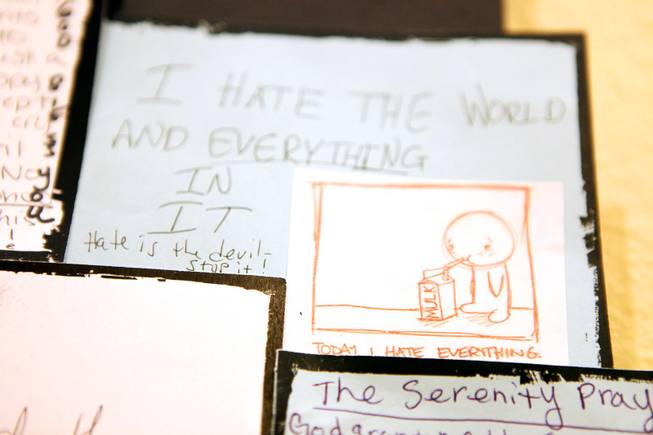
The Secret Confession wall at Green Valley Library in Henderson on Tuesday, April 10, 2012.
Wednesday, Nov. 14, 2012 | 2 a.m.
Related story
The Clark County School District is well aware of the troubling increase of teen suicides in the Las Vegas Valley.
A UNLV report released Tuesday found the number of suicides among Clark County children more than doubled from 2010 to 2011. There were 16 reported child suicides in 2011, up from seven in 2010.
The report also found Clark County's child suicide rate was nearly three times higher than the national average, although researchers did not give a clear explanation of why this was the case. Nationally, suicide is the third-leading cause of death among adolescents.
The news did not shock school psychologist Rosemary Virtuoso, the district's coordinator of student threat and crisis response department. In her 28 years with the School District, Virtuoso has seen her fair share of teen suicides.
"We weren’t surprised, but it saddened all of us," Virtuoso said of UNLV’s report, which has been released annually since 2006. "Our kids are our barometer of what's going on in the community."
In the past several years, the School District has put in place a variety of measures aimed at preventing child suicides, including a nationally recognized suicide prevention video campaign and counseling program. The district has 200 licensed psychologists, more than 100 nurses and 600 counselors who receive training to identify and help treat students thinking about suicide.
In light of the UNLV report's findings, the Sun asked Virtuoso to discuss how parents, teachers and guardians can identify students in trouble and how they can stop teen suicides from happening. This interview has been edited for clarity and brevity.
What has been the reaction among school psychologists to this report? Why do you think the child suicide rate is so high in Las Vegas?
Suicidal thoughts among children is a problem. Completed suicides are random, but there are pockets where suicide ideation — a medical term for suicidal thoughts — is more common. Broadly speaking, sometimes parents don't have a lot of resources, and families are struggling economically. Sometimes, kids feel too much pressure to achieve. There are a variety of reasons. As a district, we are trying to attack this head-on by trying to identify what the trends are and preventing it.
What is the School District doing to curb teen suicides?
A few years ago, we started showing the “Signs of Suicide” video at a couple of middle and high schools every month. This is a research-based, federally approved program that teaches kids how to watch for signs of suicide in themselves and friends. A counselor will then see the children to help. It has been a very effective way to raise awareness about this problem.
There have been a number of high-profile child suicides that have been linked to bullying and cyberbullying. What is the district doing about bullying?
There is a big concern and awareness about bullying. However, we don't make that connection between bullying and suicide because there are a number of kids who are bullied but are not suicidal.
Students can report bullying on our website, and there are statewide programs, such as Flip the Script, that address bullying. This is a national problem.
How can you tell if a child is contemplating suicide? What signs should parents and guardians look for?
Often, parents know their child better than anyone. They should see if there are drastic changes. Is their child feeling sad or hopeless, or not connected with their friends? Do they feel a sense of not belonging, of being a burden to others? Are they withdrawing more? Every kid is different, and there could be many other factors. Not every sad kid is suicidal. That's why it's important to do an emotional temperature check.
What should parents and guardians do if they feel a child is contemplating suicide?
They should talk with their kid's teachers and their school counselors, who can point them to resources.
Journalists are often wary of reporting suicide deaths because of the fear of copycat suicides and raising the profile of suicide. Is there a similar fear that calling attention to suicide in schools may encourage it?
The research is clear: Talking about suicide doesn't promote it. We are always concerned about copycat suicides, but it's better to talk about it with children.

Join the Discussion:
Check this out for a full explanation of our conversion to the LiveFyre commenting system and instructions on how to sign up for an account.
Full comments policy